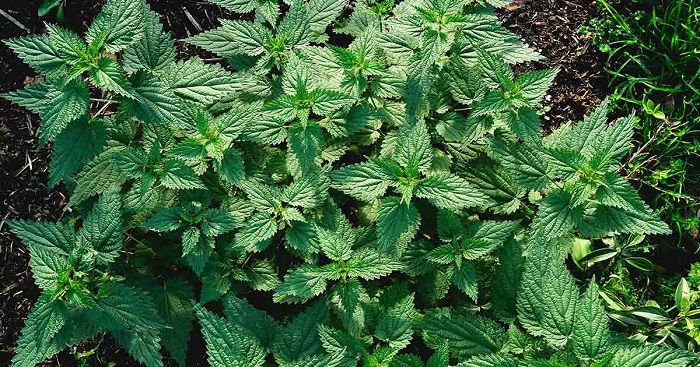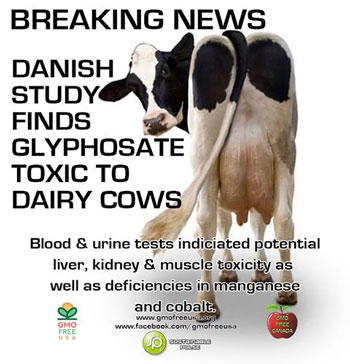
ew study reveals toxic levels of glyphosate in dairy cows
A new study published in the Journal of Environmental & Analytical Toxicology reveals that the active ingredient of Monsanto’s best selling herbicide ‘Roundup’ is found in all the dairy cows that were used for the test.
Dr. Monika Kruger and her colleagues investigated the excretion of glyphosate in the urine of 30 cows from 8 different Danish farms. The investigative team looked at blood serum parameters indicative of cytotoxicity as alkaline phosphatase (AP), glutamate dehydrogenase (GLDH), glutamate oxaloacetate transaminase (GOT), creatinine kinase CK), nephrotoxicity, (urea, creatine) and cholesterol in each of the urine samples. They also looked at trace minerals such as manganese (Mn), cobalt (Co), selenium (Se), copper (Cu) and zinc (Zn).
The results concluded that different levels of glyphosate were excreted in the urine of all cows and glyphosate had a significant impact on blood parameters of cows. In fact, the researchers found that increased levels of GLDH, GOT and CK in cows could possibly show the effect of glyphosate on liver and muscle cells. They also discovered that high urea levels in some farms could be due to nephrotoxicity of glyphosate.

In conclusion the researchers discovered that “correlations between glyphosate and some of the measured blood serum parameters to CK (R= 0.135), Se (R=-0.188), Co (R= -0,403) and Zn (R=0,175) demonstrate that glyphosate is toxic to the normal metabolism of dairy cows.”
Keep in mind that glyphostae in Monsanto’s Roundup have been linked to many chronic diseases including cancer, birth defects and infertility. Click here to find out why Monsanto’s Roundup is more toxic than what the majority believe.
Milk is anything but ‘wholesome’, despite all the claims by the main stream media and big dairy industry:
According to many scientific research and studies, increase in consumption of red meat and dairy products can increase risk of chronic diseases such as cardiovascular disease and different kinds of cancer. Click here to find out a diet high in red meat, eggs and dairy products can increase the risk of different cancers.
So what’s the best replacement for milk and dairy products?
Dairy-free organic coconut milk or organic almond milk (from real food sources, not synthetic ones that have artificial sweeteners and additives) are good replacement for milk. Keep in mind that even raw milk or goat milk can become contaminated in a number of ways, especially in large commercial farms that put profit before safety. Therefore, it’s safer to buy raw milk or goat milk from small local farmers that are highly conscious since their entire families drink the milk they produce.
Can lack of milk or dairy products cause osteoporosis and ratio of calcium to magnesium:
Many people might still believe that dairy products are necessary for healthy bones. However, the recent studies suggest that the ratio of calcium to magnesium is an important factor to health and vitality including healthy bones. As a matter of fact, 60% of the magnesium in your body is stored in bones and magnesium plays an important role in absorption of calcium and vitamins. But, 80% of Americans have magnesium deficiency and most Americans have very high ratio of calcium to magnesium (more like 6 to 1).
Many studies have concluded that the problem Western diet is high calcium intake (especially for women who are going through menopause and are at high risk of osteoporosis) without sufficient amount of magnesium.
The recommended dietary ratio of calcium to magnesium happens to be 2 to 1, however, the current research suggests that the ratio of calcium to magnesium should be more like 1 to 1.
In fact, studies show that high dietary intake of calcium and lack of Magnesium and vitamin D can increase in rate of cardiovascular diseases and strokes.
You can get your natural calcium and magnesium from food sources such as seeds, nuts, carrots, cauliflower, raw cacao beans, cabbage, broccoli and real herbal extracts (Plant based calcium with magnesium).
Growing Conditions for Stinging Nettle
Nettle can be found growing wild in many places. It’s considered a weed or invasive species by some. This lets you know it doesn’t have many specific requirements for proper growing conditions.
If you can create a bed where it will receive full or partial sunlight, you’re starting on the right foot. This bed should have nutrient-rich soil that is well-draining. Nettle thrives where it has plenty of nitrogen in the soil.
Keep in mind, nettle does prefer moisture. Consider this when deciding upon bed placement. In nature, you’ll find it growing beside natural water sources or in low-lying areas.
When growing nettle in your garden, try to place it in an area where water will naturally run toward it without leaving the plant soggy. Once you’ve determined the proper garden location for nettle, you’re ready to plant it and start the growing process.
How to Plant Stinging Nettle
Nettle can be planted using five different scenarios. The earliest way to start nettle, in a grow season, is by starting seeds indoors. The seedlings can be transplanted in early spring and should be started approximately six weeks prior to transplant.
When starting the nettle seeds, begin by placing nutrient-rich soil in a grow tray. Plant two seeds in each cell of the grow tray to ensure each pod will have a plant incase one of the seeds fails to germinate.
Don’t cover the plants heavily with soil because they need light to germinate, and you should see proof of germination within 14 days. Care for the seeds until it’s time to move outdoors. Be sure to harden off the seedlings prior to transplanting them in their outdoor bed.
When planting the seedlings, ensure you place them eight inches apart. This will give them ample room to grow as they reach maturity.
The next method to planting and raising nettle is to direct sow the seeds into a gardening space. Pick an adequate grow space with proper sunlight, soil, drainage, and moisture.
Once the spot has been determined, till the ground to where it’s ready to receive the seeds. Nettle seeds are tiny. For this reason, using the casting method to plant them is most efficient. If you’re unfamiliar with this method, it means to place the seeds in your hand and gently toss them into the garden area.
Nettle seeds need light to germinate, so you should use a small amount of soil to cover them. Wait approximately 14 days for proof of germination. When the seeds have sprouted, thin them out. You should leave roughly one inch of space between each plant.
The third planting method for nettle is to plant in a container. Choose a container with proper drainage holes and fill it with quality dirt.
Place the seeds in the dirt and lightly cover with soil. Wait 14 days for germination and once the seeds have sprouted, thin them to where there’s one inch of space between the plants.
Raising nettle in a container is a good idea because it can become invasive. By growing it in a container you eliminate this threat.
The fourth way to plant nettle is to wait until the fall when older plants are going dormant. You can divide more established plants and transplant them to a garden bed or container.
Our final way to plant nettle is to forage for it. The herb is found naturally in wooded areas. You can dig the plant up, using caution not to damage the root system, and transplant it into an inground garden space or container.
If the plant was going to seed in the wild, collect the seeds, dry them, and use them to start seeds indoors for the next grow season. You could also transplant them into an outdoor grow space or start the seeds in a container.
How to Harvest Stinging Nettle
Harvesting nettle can prove a bit tricky. The most important tip of harvesting stinging nettle is to be sure you’re covered to avoid being stung by the plant.
You should wear gloves to protect your hands, but it’s important to cover your arms, legs, and feet too.
It takes nettle approximately three months to be ready for harvest. When the stems of the stinging nettle are full and healthy, it’s an appropriate time to harvest the leaves. If the stems look older and woody, you shouldn’t harvest from the plant. As the stems dry out, the leaves become tough.
You should remove the top 1/3 of the plant when harvesting. It’s important to work from the top of the plant to the bottom.
Stinging nettle is called stinging nettle because it has needles which can poke your skin and cause a stinging sensation.
Healing Benefits
While you're not likely to find nettle leaf listed elsewhere as an adaptogenic herb, it is a star adaptogen, ideal for supporting our bodies through periods of stress. Nettle leaf contains a vast ocean of more than 700 undiscovered phytochemicals. It is life-giving and life-lengthening, an amazing anti-inflammatory for tired organs, and contains healing alkaloids yet to be discovered through scientific research. Healer Omar Botha This anti-radiation wild food is amazing for pampering the adrenal glands and other members of the endocrine system that are overburdened, overworked, and overfatigued.

Nettle Tea with Mint and Ginger Makes 3 to 6 cups Nettle’s adaptogenic qualities help us get in touch with our intuition. As you sip this invigorating invigorating tea, reflect on your intuitive abilities—how they’ve served you in the past and what they’re telling you right now. 2 tablespoons nettle leaf 2 tablespoons minced fresh mint 2 teaspoons grated ginger Mix all the ingredients together in a small bowl. Boil 4 cups of water. For each serving of tea, use 1 teaspoon of the tea blend per 1 cup of hot water.* Steep for 5 minutes or more.










